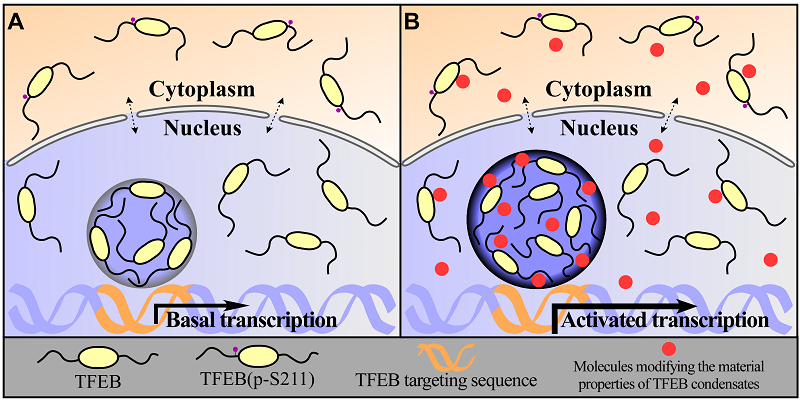Modulating the activity of intracellular pathway by the material properties of phase-separated biological condensates
Eukaryotic cells utilize biological condensates formed by liquid-liquid phase separation (LLPS) to govern various intracellular pathways. The material properties of biological condensates are closely relevant to their intracellular architecture and physiological functions. However, little is known about how biological condensates with liquid-like properties maintain as separated entities in living cells. Also, whether the material properties of phase separated-liquid condensates can be harnessed to modulate their physiological functions is still unclear.
In a study published in Journal of Cell Biology on March,16 2022, researchers from the Institute of Biophysics of Chinese Academy of Sciences revealed that the material properties of TFEB condensates modulate their fusion propensity and also transcriptional activity.
Prof. ZHANG Hong's group reported that TFEB condensates, a phase-separated condensates with liquid-like properties which are directly relevant to the transcription of genes involved in the autophagy-lysosome pathway, rarely undergo fusion events upon encountering, and are kept in a relatively fixed size both in vitro and in living cells. By measuring several material properties (including interfacial tension, viscosity and the elastic modulus) of TFEB droplets and also several other phase-separated protein droplets, the researchers found that TFEB condensates possess rigid interfacial boundaries, which prevent fusion of droplets upon encountering. Furthermore, using the unique fusion propensity of TFEB condensates as a readout, small molecular compound libraries were screened for candidates that change the fusion propensity and size of TFEB droplets. Ro-3306 and Vanillic acid were found to alter the material properties of TFEB condensates both in vitro and in living cells, which activate the autophagy-lysosome pathway in a TFEB dependent manner. This study provides mechanistic insights into how phase-separated biological condensates maintain as separated entities in living cells.

Figure. The material properties of TFEB condensates modulate their fusion propensity and transcriptional activity
ZHANG Hong is the corresponding author of this research article. This research was supported by the Chinese Ministry of Science and Technology, Beijing Municipal Science and Technology Committee, National Natural Science Foundation of China and Key Research Program of Frontier Sciences from the Chinese Academy of Sciences (CAS).
Article link: https://doi.org/10.1083/jcb.202112024
Contact: ZHANG Hong
Institute of Biophysics, Chinese Academy of Sciences
Beijing 100101, China
Email: hongzhang@ibp.ac.cn
(Reported by Dr. ZHANG Hong's group)

